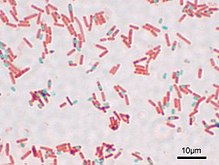
Back بوغ داخلي Arabic Endòspora Catalan سپۆڕی ناوەکی CKB Endospora Czech Endospore German Ενδοσπόριο Greek Endospòra EML Endosporo Esperanto Endospora Spanish Endospoor Estonian
This article needs additional citations for verification. (June 2010) |


An endospore is a dormant, tough, and non-reproductive structure produced by some bacteria in the phylum Bacillota.[1][2] The name "endospore" is suggestive of a spore or seed-like form (endo means 'within'), but it is not a true spore (i.e., not an offspring). It is a stripped-down, dormant form to which the bacterium can reduce itself. Endospore formation is usually triggered by a lack of nutrients, and usually occurs in gram-positive bacteria. In endospore formation, the bacterium divides within its cell wall, and one side then engulfs the other.[3] Endospores enable bacteria to lie dormant for extended periods, even centuries. There are many reports of spores remaining viable over 10,000 years, and revival of spores millions of years old has been claimed. There is one report of viable spores of Bacillus marismortui in salt crystals approximately 25 million years old.[4][5] When the environment becomes more favorable, the endospore can reactivate itself into a vegetative state. Most types of bacteria cannot change to the endospore form. Examples of bacterial species that can form endospores include Bacillus cereus, Bacillus anthracis, Bacillus thuringiensis, Clostridium botulinum, and Clostridium tetani.[6] Endospore formation is not found among Archaea.[7]
The endospore consists of the bacterium's DNA, ribosomes and large amounts of dipicolinic acid. Dipicolinic acid is a spore-specific chemical that appears to help in the ability for endospores to maintain dormancy. This chemical accounts for up to 10% of the spore's dry weight.[3]
Endospores can survive without nutrients. They are resistant to ultraviolet radiation, desiccation, high temperature, extreme freezing and chemical disinfectants. Thermo-resistant endospores were first hypothesized by Ferdinand Cohn after studying Bacillus subtilis growth on cheese after boiling the cheese. His notion of spores being the reproductive mechanism for the growth was a large blow to the previous suggestions of spontaneous generation. Astrophysicist Steinn Sigurdsson said "There are viable bacterial spores that have been found that are 40 million years old on Earth – and we know they're very hardened to radiation."[8] Common antibacterial agents that work by destroying vegetative cell walls do not affect endospores. Endospores are commonly found in soil and water, where they may survive for long periods of time. A variety of different microorganisms form "spores" or "cysts", but the endospores of low G+C gram-positive bacteria are by far the most resistant to harsh conditions.[3]
Some classes of bacteria can turn into exospores, also known as microbial cysts, instead of endospores. Exospores and endospores are two kinds of "hibernating" or dormant stages seen in some classes of microorganisms.

- ^ Murray, Patrick R.; Ellen Jo Baron (2003). Manual of Clinical Microbiology. Vol. 1. Washington, D.C.: ASM.
- ^ C. Michael Hogan (2010). "Bacteria". In Sidney Draggan; C.J. Cleveland (eds.). Encyclopedia of Earth. Washington DC: National Council for Science and the Environment. Archived from the original on 2011-05-11.
- ^ a b c Cite error: The named reference
Cornellwas invoked but never defined (see the help page). - ^ Cano, RJ; Borucki, MK (1995). "Revival and identification of bacterial spores in 25- to 40-million-year-old Dominican amber". Science. 268 (5213): 1060–1064. Bibcode:1995Sci...268.1060C. doi:10.1126/science.7538699. PMID 7538699.
- ^ Ringo, John (2004). "Reproduction of Bacteria". Fundamental Genetics. pp. 153–160. doi:10.1017/CBO9780511807022.018. ISBN 9780511807022.
- ^ "endospore" at Dorland's Medical Dictionary
- ^ Madigan, Michael T.; Bender, Kelly S.; Buckley, Daniel H.; Sattley, W. Matthew; Stahl, David A. (2018). "Microbial Cell Structure and Function". Brock Biology of Microorganisms. p. 92. ISBN 9781292235103.
- ^ BBC Staff (23 August 2011). "Impacts 'more likely' to have spread life from Earth". BBC. Archived from the original on 24 August 2011. Retrieved 2011-08-24.
© MMXXIII Rich X Search. We shall prevail. All rights reserved. Rich X Search